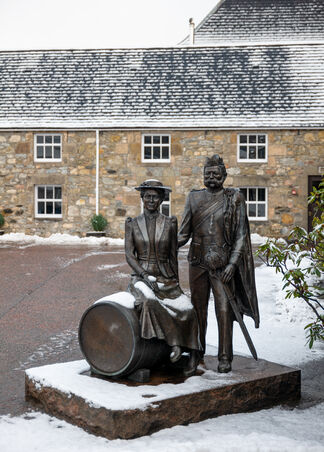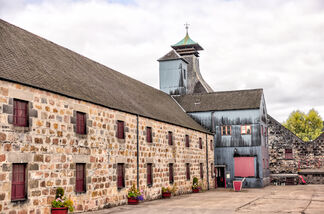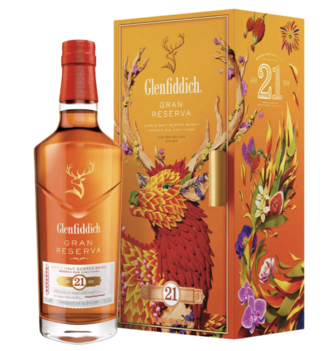William Grant & Sons Ltd.
A Family Owned Whisky Empire
William Grant Sons Ltd is the largest independent, family-owned operation in the Scotch whisky industry. William Grant and his family built a whisky empire that is the third largest whisky producer in the world. Only Diageo and Chivas produce and sell more. They have an estimated 8% global market share. Grants Family Reserve is now the fourth best-selling blended Scotch globally, while Glenfiddich is the second biggest selling single malt brand in the world with sales of 16 million bottles per year.
The founder, William Grant, was a tenacious, no-nonsense individual who walked 12 miles to buy the equipment for his first distillery, Glenfiddich. This is his story.
The Entrepreneur
William Grant was born in the village of Dufftown in Banffshire in 1839. Dufftown was home at that time to a single distillery, Mortlach.
He went to Mortlach school only when his parents did not need him to herd cattle. His first job was as an apprentice to a Dufftown shoemaker. He married local girl, Elizabeth Duncan, in 1859. A year later, the first of their 11 children was born (although two died in infancy).
In 1866, after a brief period at Tiniver Lime Works, he became clerk at Mortlach distillery. He was a smart and hard worker and owner George Cowie recognised his contribution by appointing him to Manager.
But William wanted to establish himself as a distiller in his own right. This was extremely ambitious for a man with a salary of less than £100 a year and 9 young children to provide for! But the family scrimped and saved every penny possible.
Grant’s dream of creating his own distillery became a reality when, in 1886, he heard that the old distilling plant at Cardow (now Cardhu) distillery was to be sold off. He walked 12 miles to Cardow in order to make an offer, and was able to acquire everything for the price of £119 19s 10d.
The Distilleries
His distillery was located in a field called Glenfiddich, just North of Dufftown. The building of the Glenfiddich distillery started in the late autumn of 1886. The majority of the building work being done by William and his sons. Where possible, stones from the bed of the River Fiddich were used, but for larger structures, such as the warehouse and malt barn, stone was purchased from the local quarry.
Work went on through the summer of 1887, and the first spirit flowed on Christmas Day of that year, only 18 months after building work began. The total cost of creating Glenfiddich distillery was £800, a remarkably modest sum, even for the time.
Glenfiddich soon proved a great success, being widely sought-after by blenders. And in 1892, the Grant family decided to open a second distillery on land next to Glenfiddich. This second distillery is Balvenie, and it was built around the uninhabited mansion of Balvenie New House, formerly one of the residences of the Duke of Fife.
Challenges and Expansion
The Grants now owned two distilleries producing malt whisky, supplying the whisky blending and bottling industry of Scotland. But in December 1898, disaster struck. their largest customer, the Leith blending firm of Pattisons Ltd, collapsed. Most whisky distillers would have seen this as a major problem, but to the Grants, this was an opportunity to expand their operation. And William and his family began blending and bottling whisky in their own right. This was the beginning of taking their business global. William’s daughter, Isabella, married Charles Gordon, who became the company's first salesman. In 1909, Charles Gordon began travelling to export Glenfiddich around the world. By 1914, he had established distribution networks in 30 countries.
In 1923, with prohibition taking hold and whisky exports to the larget market, America, evaporating, Williams grandson joined the company and surprised the industry by increasing whisky production. Other distilleries were closing down, or being put into mothballs. But it proved to be a wise and profitable move. When prohibition ended, and demand rocketed, only a handful of distilleries had sufficient stock to meet demand. William Grant & Sons was in a position to take this huge growth opportunity.
Grant's whisky empire was established and wanted to re-brand. In 1961, Glenfiddich whisky was given a new look and bottled in the (now familiar) triangular bottle called a “Tround”. The 3 sides represent barley, water and air. A nice touch I think!
The Grant Generations
William Grant died on 5 January 1923, aged 83, after being confined to his bed for a decade. He is buried in Mortlach Churchyard, just across the River Dullan from the former family home at Hardhaugh, and opposite the grave of his father. His family and decendents have continued to head up and lead the family business.
The current chairman is Glenn Gordon, great grandson of founder William Grant. He has a reported wealth of over 3 Billion Pounds. The Grant family has set up a Foundation to enable positive change in Scotland. 1% of pre-tax profits are assigned to the foundation annually. In 2023, grants were awarded to 92 causes in 83 organisations to a value of over 4.7 million pounds.
Is whisky healthy? Well William Grant’s granddaughter (Janet Roberts) lived to the ripe old age of 110. She died in 2012 as the oldest living person in Scotland. Bottles of whisky were produced in her honour to mark her 100th, 105th, 107th and 110th birthdays. The Grant's are a hardy and generous bunch!
The Whiskies
The range of whiskies from William Grant is vast and there are too many to review here. The single malts of Glenfiddich, Balvenie and Ailsa Bay alone demonstrate a diverse range. But a highlight in the range, if you happen to have a spare 170€ or so is the Glenfiddich 21 year old Gran Reserva.
It is a fabulous 21 Year Old bottling from Glenfiddich, and as its name suggests, this particular single malt was finished in Caribbean Rum casks for 4 months. There is tropical fruit and spicy ginger to be found in here.
Nose: Malt and dark brown sugar, with orange peels, honey, and chocolate.
Palate: Fruitcake, spices, buttery vanilla, malty, with oak and candied ginger.
Finish: Long, with notes of coffee and marmalade.
A perfect dram for Christmas, but a tad expensive. One to try in a bar if you are lucky enough to find it!



